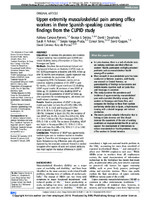Upper extremity musculoskeletal pain among office workers in three Spanish-speaking countries: findings from the CUPID study

Fecha
2016Autor
Campos-Fumero, Adriana
Delclos, George
Douphrate, David
Felknor, Sarah
Vargas-Prada, Sergio
Serra, Consol
Coggon, David
Ruiz-De Porras, David Gimeno
Metadatos
Mostrar el registro completo del ítemResumen
Objectives To estimate the prevalence and incidence
of upper extremity musculoskeletal pain (UEMP) and
related disability among office workers in Costa Rica,
Nicaragua and Spain.
Methods Data from the multinational Cultural and
Psychosocial Influences on Disability (CUPID) study on
947 (93%) participants at baseline with 90% follow-up
after 12 months were employed. Logistic regression was
used to estimate the associations (ORs and
corresponding 95% CIs) between country and six
outcomes: baseline prevalence of (1) UEMP in past
12 months, (2) UEMP in past month and (3) disabling
UEMP in past month; (4) incidence of new UEMP at
follow-up; (5) incidence of new disabling UEMP at
follow-up and (6) persistence of UEMP at follow-up,
after adjustment for sociodemographic, job-related and
health-related covariates.
Results Baseline prevalence of UEMP in the past
month was higher in Costa Rica (53.6%) (OR=1.89;
95% CI 1.36 to 2.62) and Nicaragua (51.9%)
(OR=1.74; 95% CI 1.28 to 2.35) than in Spain
(38.4%). Compared to Spain (33.2%), the incidence of
new UEMP was 50.4% in Costa Rica (OR=2.04; 95%
CI 1.34 to 3.12) and 60.2% in Nicaragua (OR=3.04;
95% CI 2.06 to 4.50). The incidence of disabling UEMP
was higher in Nicaragua (OR=2.57; 95% CI 1.50 to
4.41) and Costa Rica (OR=2.16; 95% CI 1.22 to 3.84)
when compared to Spain.
Conclusions Prevalence of UEMP was approximately
twofold higher and its incidence twofold to threefold
higher in Costa Rica and Nicaragua as compared with
Spain. Between-country differences were only partially
explained by the covariates analysed. Research is needed
to explore other aspects of work and cultural attributes
that might explain the residual differences in UEMP.
Descripción
Artículo científico
Fuente
Occupational and Environmental MedicineCompartir
Métricas
Colecciones
- Artículos [29]

